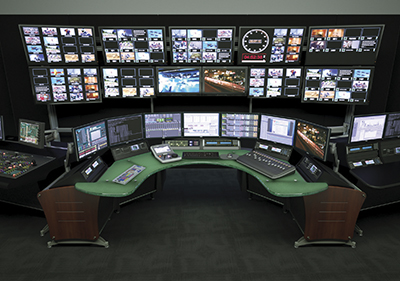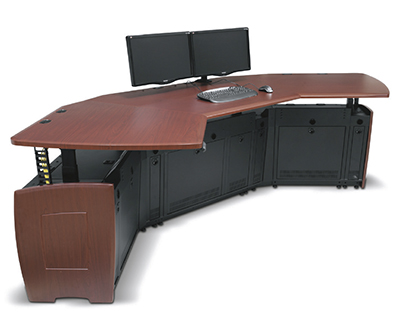Eye On: Furniture Designed for Comfort

TBC Consoles’ Single Operator Integrated Production SystemOTTAWA—There was a time when TV master control rooms resembled Cold War-era sci-fi movie sets, with heavy, equipment-packed consoles, heat-pulsing walls of CRTs, massive VTRs and patch panels—none of which were designed to put human comfort first. But as TV production equipment has been transformed from analog tubes to digital servers, the furniture that serves production environments has also changed. And today, ergonomics matters.
“In particular, the production console has been changing,” said Bill Haberman, president/CEO of Forecast Consoles in Hauppague, N.Y. “This is because, compared to older consoles, very little if any under counter bay space is required in today’s consoles. Meanwhile, monitoring has greatly expanded and space is at a premium. Skillful placement with ultra-flexibility are critical to viewing sightlines and readability.”
TV production staff can thank computer technology for freeing up space around their working areas. With most production functions moving into server-based software— which can be located away from the console with only a monitor, mouse and keyboard needed for the operator to control it—there’s suddenly much more space for people to move their legs under the desk, and their arms on top of it.
At the same time, the transition from hard control surfaces to virtual switchers accessed via touchscreens is physically changing console dimensions. “It used to be a broadcast console desktop had to be 22-24-inches deep to have room for the video switcher and audio mixer,” said Jerry Hahn, president of TBC Consoles in Edgewood, N.Y. “With the move towards touchscreens and on-table LCD monitors, depths are shrinking to 17-18 inches. This takes less space out of master control, allowing more freedom in laying out work areas and generally moving around them.”
In TV’s analog days, walls of bulky, heat emitting CRT monitors were the norm in TV production rooms. Thanks to digital, these boxes have been replaced by LCD flat panel displays. Better yet, the advent of flexible multi viewer systems has made it possible for one large LCD to be reconfigured into multiple monitor windows as needed.
“The move to large flat panel monitor technology—both on the desktop and the wall—has made it possible to move to lower-profile consoles,” said Hahn. “Basically, this means that there is less strain on the operator’s eyes and neck, because they don’t have to raise and lower their heads as much. There are fewer monitors to look at, even though these monitors are probably able to source more feeds than ever before.”
A MATTER OF DESIGN
Maximizing ergonomic comfort—and avoiding repetitive neck injuries—is a matter of design. This is why Fairfield, N.J.-based Middle Atlantic Products offers its Middle Atlantic Designer 3D Layout Software as a free download at www.middleatlantic.com/sec/viewpoint/Designer-Software.htm. The program lets engineers design master control and other production areas in 3D, right down to the placement of desks and chairs.
But that’s not all. “Designer 3D even lets you put sitting or standing virtual technicians at the various work areas you’ve drawn, so that you can see things from their perspective,” said Kevin Handerson, Middle Atlantic’s marketing director. “There’s a tool that emits what appears to be a ‘blue freezing ray’ from the operator’s eyes. It’s a cone-shaped graphic that shows you what the operator can, and cannot, see without moving their head. Using this data, you can move monitors and other equipment to optimum position, then print out the drawings for use in actual construction.”

Middle Atlantic Viewpoint furniture with new height-adjustable sit/stand functionality With the medical establishment reminding us of the health dangers of sitting all day, broadcast furniture designers are taking ergonomics more seriously. For instance, medical doctors now say that the healthiest way for office staff to work is by alternating between sitting and standing; in response, these companies are designing adjustable work stations whose surfaces can be raised or lowered quickly to support either position.
The move to single operator control rooms is also being noted in modern furniture design. “This is why many master control layouts are being put together like a ‘single person cockpit, so that one operator can access everything without having to roll their chair around the room,” Hahn said.
Even small details such as tabletop sharp edges are being modified. “It may not seem like a big deal to have a rounded edge on a control surface, but the fact is that sharp edges can cause bruising over time,” Handerson said. “We’re taking these details into account.”
When it comes to broadcast furniture, we are living in the “golden age of ergonomics,” according to Handerson. “That’s how responsive our industry has become to our client’s physical comfort and needs.” In turn, broadcasters and production studios can now outfit their facilities with broadcast furniture that not only improves workflow, but ensures that their staff is more comfortable, better-rested, and less prone to workplace injuries over time.
Get the TV Tech Newsletter
The professional video industry's #1 source for news, trends and product and tech information. Sign up below.
James Careless is an award-winning journalist who has written for TV Technology since the 1990s. He has covered HDTV from the days of the six competing HDTV formats that led to the 1993 Grand Alliance, and onwards through ATSC 3.0 and OTT. He also writes for Radio World, along with other publications in aerospace, defense, public safety, streaming media, plus the amusement park industry for something different.

